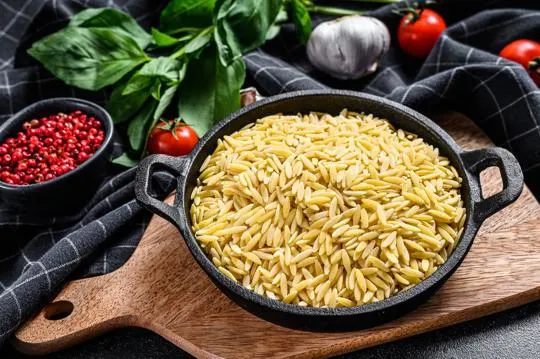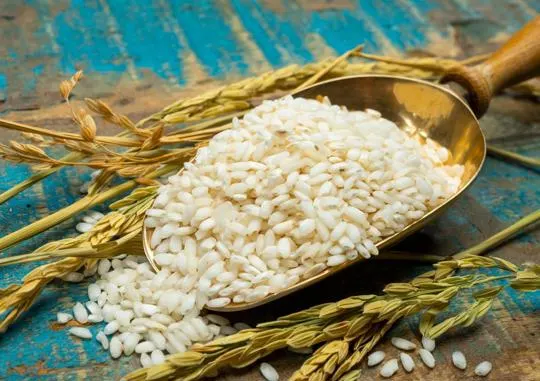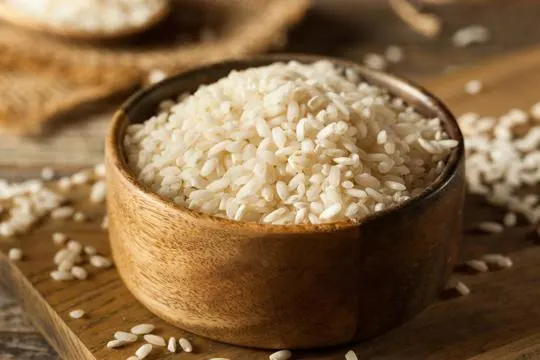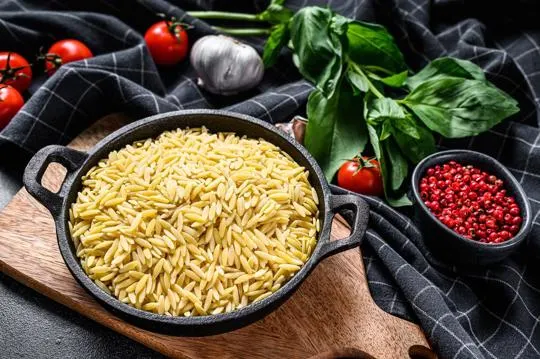Summary of key points
The primary difference between orzo and Arborio lies in their fundamental nature; orzo is a type of pasta made from wheat flour, offering higher protein and fiber, whereas Arborio is a rice variety, specifically used in making risotto due to its high starch content that contributes to the dish’s creamy texture (Cucina by Elena, TikTok @rosereisman).
Have you ever stood in the pasta aisle, utterly baffled by the array of choices? Orzo and Arborio rice stare back, taunting with their subtle differences.
We’ve all been there. Decision paralysis over grains. It sounds silly, right? Yet, here we are, trying to make an educated pick.
Orzo looks like rice, fooled me more than once. Arborio, on the other hand, is the backbone of a good risotto.
They’re not interchangeable. Learned that the hard way. Family dinner, a bit of a disaster.
In this guide, we’re breaking it down. No more guessing games at the grocery store.
We’ll show you what sets them apart and why it matters for your cooking. Because no one likes a risotto that resembles soup. Or was it a soup that aimed to be a risotto?
What is Orzo?

Orzo – a pasta that looks like grains of rice – is a versatile ingredient for Italian cooking.
Its shape and texture give dishes an interesting twist.
What sets orzo apart? Its ability to absorb flavors and stay firm when cooked.
Unlike rice, it won’t get mushy if overcooked.
This makes it perfect for soups, salads, pilafs, and casseroles.
Orzo also stands out visually.
Its tiny grains give dishes a sophisticated look.
Whether served with veggies, meats, or seafood, orzo adds visual interest to the plate.
Plus, orzo is packed with nutrition.
Made from durum wheat semolina, it has fiber, protein, iron, and B vitamins.
These nutrients help maintain good health.
What is Arborio Rice?

Arborio rice is a short-grain Italian type, renowned for its special features.
It can absorb flavors, while keeping a creamy texture.
Here are 4 aspects that make it so unique:
- Creaminess: It has high starch content, releasing starch as it cooks, making it creamy.
- Versatility: It’s the go-to for risotto dishes, taking on flavor from the broth and ingredients.
- Texture: Plump and slightly firm exterior, with a tender center.
- Absorption: It can take up a lot of liquid during cooking without losing shape.
Moreover, Arborio rice stays somewhat resistant in the middle when cooked well – providing an al dente texture.
That’s how it stands out from other kinds of rice, letting you explore multiple culinary possibilities.
Differences Between Orzo and Arborio

Orzo and Arborio are two types of rice used in cooking.
But, they are different.
Appearance and Shape
Orzo and Arborio rice: two types that look alike.
But, upon closer inspection, they are different.
Orzo looks like tiny cylinders or pasta pearls.
Arborio is plump and round.
There’s more to explore than just their looks.
Orzo is great in soups and salads for its flavor-absorbing qualities.
Arborio is famous for creamy risottos.
So, when choosing between the two, it’s a delightful dilemma for cooks.
Ingredients and Grain Type
Orzo and Arborio are two grains with varied tastes, textures, and culinary purposes.
Orzo is dubbed as “rice-shaped pasta,” made from durum wheat semolina.
It’s small size makes it ideal for soups, salads, and pilafs.
Meanwhile, Arborio rice is short-grain and famed for its high starch content.
This gives it a creamy texture when cooked and it’s used in risottos and rice puddings.
Orzo is boiled like pasta until tender.
It absorbs flavors and takes on the taste of the dish.
Arborio rice requires the “risotto method” – adding hot liquid while stirring to release starches and create a creamy consistency.
Orzo has a nutty taste that pairs well with veggies, herbs, and cheeses.
Its texture is similar to al dente pasta.
Arborio rice has a milder flavor with a sweet undertone.
Its creamy texture adds richness but still has a firm bite.
To sum up: orzo is from wheat and looks like rice but has pasta-like qualities; Arborio rice is short-grain with high starch content and creamy when prepared with the risotto method.
Texture and Cooking Method
Orzo and Arborio rice have different textures and cooking methods.
Orzo, a pasta-like grain, is firm yet smooth.
You boil it in salted water for 8-10 minutes until al dente.
It’s great for salads, soups, or to use as a rice substitute.
Arborio rice is a short-grain Italian rice that gets creamy and chewy when cooked.
Folks use it to make risotto because it absorbs flavors and releases starch.
You simmer it with liquid (e.
g.
broth or wine) and stir until it’s creamy.
Orzo doesn’t require constant stirring like Arborio rice does.
But both benefit from slow cooking with liquid, which lets them absorb flavors and develop texture.
In conclusion, orzo has a firm, smooth bite perfect for various dishes.
Arborio rice is best in risotto recipes; creamy and chewy.
Knowing the differences helps you make tasty meals with either ingredient.
Culinary Uses
Orzo and Arborio are two types of rice used in cooking.
They have different qualities and are used in various dishes to enhance flavors.
Orzo is a small pasta shape that looks like rice grains.
It is great for soups, salads, and pilafs.
It has a good flavor and adds texture.
Arborio rice is a short-grain type.
It is mainly used for making risotto.
Its high starch content gives risotto a creamy texture.
Orzo and Arborio have unique uses.
Orzo’s small size helps to add volume and bulk to soups and stews.
It cooks quickly, making it ideal for busy cooks.
Orzo can also be baked, sautéed, or used as a base for casseroles.
Arborio is best suited for Italian cuisine.
It makes rich and creamy risottos.
Its starch content is released slowly when cooked, giving risotto a velvety texture.
Arborio is the key to making perfect risotto, as it absorbs liquids without becoming mushy.
To sum up, Orzo and Arborio are similar but have different uses.
They can be used to make tasty meals bursting with flavor.
So try out their culinary uses.
Similarities Between Orzo and Arborio

Orzo and Arborio – two types of rice – are often used in cooking.
They look similar, with Orzo being elongated and Arborio more rounded.
Texture-wise, both absorb flavors well.
This makes them great for risottos, pilafs, soups and salads.
They also have a creamy consistency when cooked, making for a satisfying and comforting experience.
All in all, these two grains offer a wide range of culinary options due to their similar attributes.
Recipes and Dishes Using Orzo and Arborio
Orzo and Arborio are two tasty ingredients that can be used in a multitude of recipes.
Orzo, resembling small grains of rice, is great in salads, soups, and side dishes.
While Arborio rice is perfect for classic Italian risottos due to its creamy texture that retains its shape when absorbing liquid.
To get the most out of these ingredients, pair them with complementary flavors.
For example, combine orzo with fresh herbs, vegetables, and feta cheese for a Mediterranean-inspired salad.
And for Arborio rice, try wild mushrooms, parmesan cheese, and white wine for a flavorful risotto.
Conclusion
After reviewing all the pertinent details and facts about the difference between orzo and arborio, it is clear that these two grains have a lot of differences in terms of taste and texture.
They both have unique qualities that make them perfect for different recipes.
Orzo has a thinner profile that works well with soups and salads, while arborio has a thicker texture that works great as a risotto.
While both can be used for various dishes, you need to be aware of the difference before you start cooking with either one.
Knowing their particular strengths will ensure you create tasty, satisfying meals every time.
No matter which grain you choose for your next dinner dish, we are sure it will turn out delicious.

Leave a comment